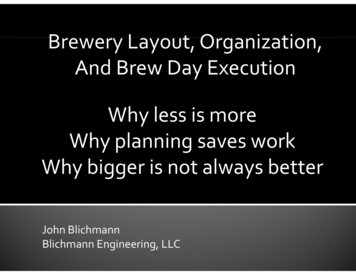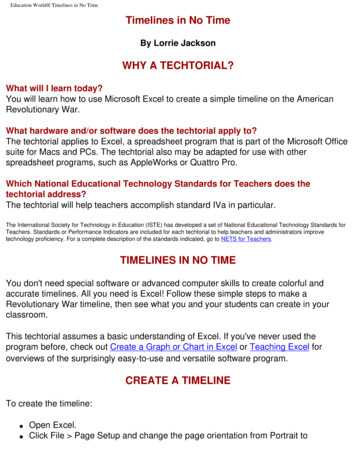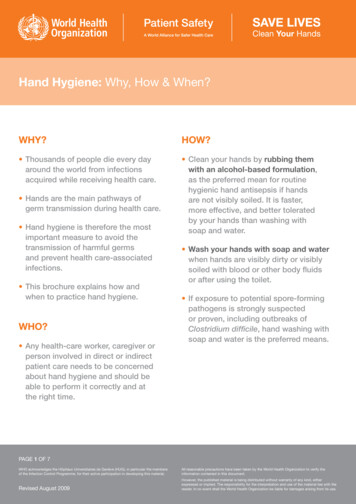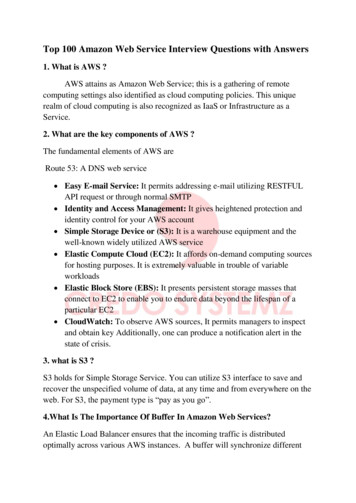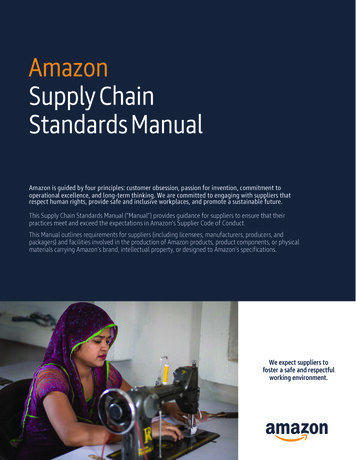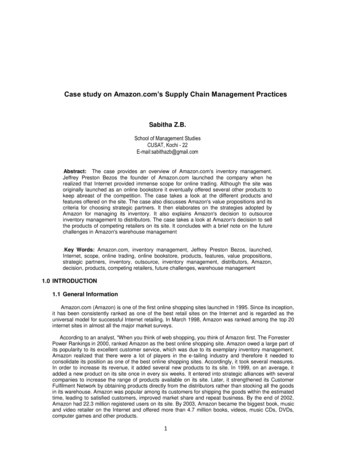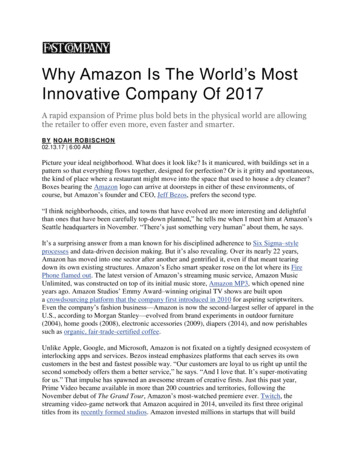
Transcription
Why Amazon Is The World’s MostInnovative Company Of 2017A rapid expansion of Prime plus bold bets in the physical world are allowingthe retailer to offer even more, even faster and smarter.BY NO AH RO BISC HO N02.13.17 6:00 AMPicture your ideal neighborhood. What does it look like? Is it manicured, with buildings set in apattern so that everything flows together, designed for perfection? Or is it gritty and spontaneous,the kind of place where a restaurant might move into the space that used to house a dry cleaner?Boxes bearing the Amazon logo can arrive at doorsteps in either of these environments, ofcourse, but Amazon‘s founder and CEO, Jeff Bezos, prefers the second type.―I think neighborhoods, cities, and towns that have evolved are more interesting and delightfulthan ones that have been carefully top-down planned,‖ he tells me when I meet him at Amazon‘sSeattle headquarters in November. ―There‘s just something very human‖ about them, he says.It‘s a surprising answer from a man known for his disciplined adherence to Six Sigma–styleprocesses and data-driven decision making. But it‘s also revealing. Over its nearly 22 years,Amazon has moved into one sector after another and gentrified it, even if that meant tearingdown its own existing structures. Amazon‘s Echo smart speaker rose on the lot where its FirePhone flamed out. The latest version of Amazon‘s streaming music service, Amazon MusicUnlimited, was constructed on top of its initial music store, Amazon MP3, which opened nineyears ago. Amazon Studios‘ Emmy Award–winning original TV shows are built upona crowdsourcing platform that the company first introduced in 2010 for aspiring scriptwriters.Even the company‘s fashion business—Amazon is now the second-largest seller of apparel in theU.S., according to Morgan Stanley—evolved from brand experiments in outdoor furniture(2004), home goods (2008), electronic accessories (2009), diapers (2014), and now perishablessuch as organic, fair-trade-certified coffee.Unlike Apple, Google, and Microsoft, Amazon is not fixated on a tightly designed ecosystem ofinterlocking apps and services. Bezos instead emphasizes platforms that each serves its owncustomers in the best and fastest possible way. ―Our customers are loyal to us right up until thesecond somebody offers them a better service,‖ he says. ―And I love that. It‘s super-motivatingfor us.‖ That impulse has spawned an awesome stream of creative firsts. Just this past year,Prime Video became available in more than 200 countries and territories, following theNovember debut of The Grand Tour, Amazon‘s most-watched premiere ever. Twitch, thestreaming video-game network that Amazon acquired in 2014, unveiled its first three originaltitles from its recently formed studios. Amazon invested millions in startups that will build
voice-control apps for the intelligent assistant Alexa and give her thousands of new skills. Thecompany opened two dozen new fulfillment centers, became the largest online store in India, andmade its first delivery by autonomous drone in the United Kingdom.Bezos‘s strategy of continuous evolution has allowed the company to experiment in adjacentareas—and then build them into franchises. The website that once sold only books now letsanyone set up a storefront and sell just about anything. The warehouse and logistics capabilitiesthat Amazon built to sort, pack, and ship those books are available, for a price, to any seller.Amazon Web Services, which grew out of the company‘s own e-commerce infrastructure needs,has become a 13 billion business that not only powers the likes of Airbnb and Netflix, but storesyour Kindle e-book library and makes it possible for Alexa to tell you whether or not you‘ll needan umbrella today.Amazon is a singular enterprise, one that rises to the top of Fast Company’s Most InnovativeCompanies list because it has continued to be nimble even as it has achieved enviable scale. Totruly understand how Bezos is meshing size and agility in 2017, though, you need to look beyondsales figures ( 100 billion in 2015) and the stock price (up more than 300% in the past fiveyears) and consider three initiatives that drive Amazon today: Prime, the company‘s rapidlyproliferating 99-per-year membership program; an incursion into the physical world with brickand-mortar stores, something the company has long resisted; and a restless rethinking oflogistics, epitomized by a new fulfillment center an hour outside Seattle that features high-techrobots working alongside human workers like a factory of the future.Our mobile-first, on-demand world finds its roots in Amazon‘s founding idea: that digitalcommerce will radically reshape our marketplace. The company‘s impact has already beenstaggering. In January, the nonprofit Institute for Local Self-Reliance conducted a survey ofnearly 3,000 independent businesses, half of them retailers, asking them to cite the biggestthreats they faced. Competition from chains and big-box stores, health care, finding employees,and rising rents all ranked near the bottom as modest concerns. ―Way above everything wascompetition from Amazon,‖ says ILSR codirector Stacy Mitchell. (The study also found thatAmazon‘s expansion in 2015 led to a net loss across all businesses of 149,000 jobs.)Despite all the twists and surprises in recent decades—all the newcomers with youth, funding,and can-do enthusiasm—Amazon remains the undisputed leader, a startup at heart still striving toremake our expectations. And to repeatedly remake itself.Nearly all of Amazon‘s most recent innovations share a connection to Prime, which by someestimates accounts for 60% of the total dollar value of all merchandise sold on the site. Between40 million and 50 million people in the United States use Prime, and, according to MorganStanley, those customers spend around 2,500 on Amazon annually, more than four times whatnonmembers spend. (Amazon refuses to offer any hard numbers related to Prime membership—that would be competitor focused rather than customer obsessed, as the executives there say—but it will confirm that Prime members spend more and shop across a greater number ofcategories than other users.)
If you somehow manage to take advantage of every Prime membership feature, it‘s undeniably agood bargain. Along with free two-day shipping for millions of products, and tens of thousandsof items available at your door in an hour or less through Prime Now, there is one-hourrestaurant delivery, a free e-book a month (including the entire Harry Potter series), and ad-freeviewing of a streaming video-game channel on Twitch—all included in the annual fee. You canget early access to Amazon‘s best deals, 20% off diapers, and unlimited photo storage. For a fewmore dollars, Prime can be upgraded to include unlimited audiobooks, grocery delivery, and asubscription to HBO that can be watched on Amazon‘s Fire TV streaming media player. Morethan 50 ―benefits‖ were added for members around the globe in the second half of 2016 alone,says Greg Greeley, Amazon‘s global VP in charge of Prime. ―I would like to say that the teamthinks, ‗Oh, boy, we‘ll take a deep breath here,‘ ‖ he says. ―But the way this company [is], itwouldn‘t surprise me if we continue to keep accelerating.‖What Amazon Prime is selling most of all is time. Every executive I spoke to, when asked abouthow it all fits together, cites this desire to get you whatever you want in the shortest windowpossible. Stephenie Landry, the Amazon vice president who launched Prime Now in 2014 andhas overseen its expansion into 49 cities in seven countries, explains that her business merely hasto answer two questions: ―Do you have what I want, and can you get it to me when I need it?‖The rest of the customer experience is built around answering both questions in the affirmative.The more products and services Amazon is able to cram into Prime, the more likely users are torenew their membership and buy more stuff, which gives Amazon more data about their tastesand what they are likely to buy next. That information is used to spin out new products andservices, such as the Dash button, which replenishes popular items with a tap, and Alexa, whichis built, in part, for shopping. ―You can just say, ‗Alexa, reorder toothpaste,‘ ‖ says Bezos. ―Andit knows which kind of toothpaste.‖ That‘s why he has repeatedly called Prime the company‘s―flywheel‖: a device used in engines that provides constant energy. It is both an accelerant toAmazon‘s forward motion and a beneficiary.Bezos says that people have been asking him for 20 years whether he would ever open physicalstores. The answer, consistently, has been no. ―I‘ve answered pretty much the same way thewhole time, which is that we will if we have a differentiated idea,‖ Bezos tells me. Yet today,suddenly, Amazon has four concepts in the works.Why the shift? In part it links back to Prime; retail stores offer a tangible lure for the uninitiated.But, as Bezos explains, Amazon‘s technological sophistication also now makes it possible for instore shoppers to interact with its digital platforms in all-new manners. Monitoring the interplayis a classic Amazon way to spot new opportunities.The first wave of Amazon stores is somewhat traditional: More than 30 pop-up shopsshowcasing Amazon‘s electronic gadgets—Kindle, Echo, Fire TV, Fire tablets, and Dashbuttons—dotted the country by late last year. The next phase: expanding the highly curatedAmazon Books stores—which showcase titles with a higher-than-four-stars customer ratingalongside excerpts of reviews from the website—from three locations to eight. But it is the thirdleg of the company‘s retail experiment that begins to rattle expectations. Amazon Go is aconvenience-store concept the company announced in December (it will launch publicly in
Seattle in early 2017). After a shopper swipes a code on her mobile phone at the entrywayturnstile, she can grab whatever items she likes; they are magically added to her digital cart andautomatically paid for when she leaves, through her existing account. This ability to skip boththe line and any cash register on the way out is made possible by Amazon‘s cloud computing,machine learning, voice control, and logistics know-how. It‘s also another example of Amazoncreating a technology platform that could be sold to other businesses.Finally, and more quietly, another grocery-store concept is also being prepped. Although no oneinside Amazon is willing to talk about it, documents filed with local buildings departments inSeattle and the San Francisco suburbs of Sunnyvale and San Carlos show that the company iserecting stores in all three locales. (Construction at the Seattle location—where a Chineserestaurant once stood, on a busy commercial thoroughfare in the fast-growing Ballardneighborhood—appears to be nearly complete.) The documents describe a system that wouldseem to extend the AmazonFresh grocery service: Customers load their digital carts remotelyand pay online, then schedule a physical pickup within a two-hour window. ―When picking uppurchased items, customers either can drive into a designated parking area with eight parkingstalls where the purchased items will be delivered to their cars, or they can walk into the retailarea to pick up their items,‖ the filings say.These stores are not likely to change the way most Americans get their cornflakes overnight.Still, Amazon has always been good at being patient—and incrementally improving its offerings.Since AmazonFresh launched in 2007, the service has slowly expanded to dozens of cities. TheAmazon neighborhood continues to change.Planted on the edge of a military base, Amazon‘s recently opened fulfillment center, in DuPont,Washington, looks from the outside like a generic warehouse, with a line of idling trucks snakingaround the building waiting to load and unload product. But what‘s inside represents a hugeadvance in the way Amazon sorts, packs, and ships orders.It starts with a ―vision tunnel,‖ a conveyor belt tented by a dome full of cameras and scanners.As each box comes off the truck, it is photographed and scanned on all sides. Image-recognitionalgorithms then sort each parcel based on variables such as the type of product or size andweight. What takes humans with bar-code scanners an hour to accomplish at older fulfillmentcenters can now be done in half that time.Boxes are towed from the docks into the million-square-foot warehouse, sometimes by driverlessvehicles. This facility handles the largest items that Amazon ships, which is why there‘s also ahuge, 6-ton yellow robot on the main floor. It has a six-axis arm that could pick up a car withease, but today it‘s mostly lifting pallets loaded 4 feet high with diapers and Keurig cups to thesecond floor of the warehouse where they will await shipping. The arm performs a constant,mostly silent waltz with an ensemble of rolling Amazon robots, which represent the nextgeneration offspring of the company‘s 775 million acquisition of Kiva Systems in 2012, andwere only fully integrated into the fulfillment center workflow last year.
Once a package leaves the warehouse, it may end up on a Boeing 767 with the Prime Airlogo emblazoned on its side. Bezos rolled out the first in a fleet of 40 wide-bodies last summer,which will be operated in partnership with two aircraft-leasing companies. In January, Amazonannounced that the fleet would be supported by a new air hub in Kentucky that will employ2,000 workers—a 1.49 billion investment, according to a spokeswoman with theCincinnati/Northern Kentucky International Airport. The planes, like the thousands of cargotrailers that already sport the Prime logo, make Amazon less dependent on its partnerships withFedEx, DHL, and the United States Postal Service. And, pending FAA approval, those fullyoperational Amazon delivery drones might one day cut delivery time down to 30 minutes or less.Amazon stresses that its new automated fulfillment centers actually require more human workersthan the old ones did, because the warehouse can store a significantly larger number ofproducts—which all still need people for boxing and general oversight (plus, someone‘s got toservice those robots when they need repairs). The plant in DuPont, active almost 24/7, employsmore than a thousand people full time. At stow station 1405, for instance, I watch a young guywith tattoos, a man bun, and large-gauge flesh-tunnel earrings grab item after item from orangerobots, scan each one, and, after the computer gives the green light, send it to be boxed. Over theholiday season, Amazon hired an extra 120,000 workers at centers nationwide to help meetdemand. This is what the future of American factory work might look like.Amazon‘s business is not without its challenges. The company‘s imperative to deliver more stufffaster has racheted up its annual shipping costs north of 11 billion, reinforcing the pressure towring efficiencies out of the company‘s processes and its people. In the run-up to last year‘sholiday shopping season, pilots who work for Amazon‘s Prime Air shipping contractors went onstrike, demanding hiring increases to reduce their workload. It‘s no wonder that the blistering2015 New York Times article about bruising work environments at Amazon remains in thepopular consciousness.
Amazon is working to counteract this legacy. The company pledged in January to create morethan 100,000 full-time positions over the next 18 months, and it‘s building a new headquarterscomplex in the heart of downtown Seattle. Five buildings and a 2,000-seat auditorium willsurround a trio of glass-enclosed spheres that, when completed in 2018, will contain more than3,000 species of plants and trees from around the world. There will be flexible, couch-filled workspaces and an ―Expressions Lab,‖ where employees can learn to knit or attend a ―Bob Ross PaintNight.‖ One floor will include a small outdoor dog park, and there will be several markets andcafeterias. Amazon is also funding an additional streetcar for the city, as well as bicycle pathsleading to the three-block complex, which includes 1.7 acres of public space. ―The biggest thingis probably just that we‘re not in a suburban campus,‖ says Bezos, ―which I think would changethe vibrancy and energy of Amazon.‖In November, Amazon released a video ad portraying a pair of aging friends—a priest and animam—laughing, hugging, and then ordering the same knee braces for each other. It is asensitive and moving vignette, portraying Amazon as a connector of cultures, the kind ofcompassionate business it has not always been given credit for being. The ad arrived just twoweeks after Donald Trump was elected president, so I ask Bezos what the company‘s role mightbe in bridging the divides that exist in the U.S. After all, he bankrolls the Washington Post,which went after Trump aggressively during the presidential campaign (and was an early andinfluential opponent of Trump‘s immigration ban). His answer is almost laughably narrow.―Well, I‘ll tell you one way that I don‘t think anybody is divided,‖ Bezos replies. ―Everybodywants fast delivery. Low prices. I‘m serious about this. Our job is to provide a great customerexperience, and that is something that is universally desired all over the world.‖It‘s tough to argue with his words. And yet this Bezosian boilerplate is certainly less than the fullstory. Because Amazon is doing more than delivering our next tube of toothpaste. By using the―divine discontent of the customer as a North Star,‖ as Bezos puts it, the company is energizing aculture of relentless progress. The neighborhood may be changing, but maybe that‘s good.Maybe that‘s what business in the modern era is all about.
and can-do enthusiasm—Amazon remains the undisputed leader, a startup at heart still striving to remake our expectations. And to repeatedly remake itself. Nearly all of Amazon‘s most recent innovations share a connection to Prime, which by some estimates accounts for 60% of the total dollar

